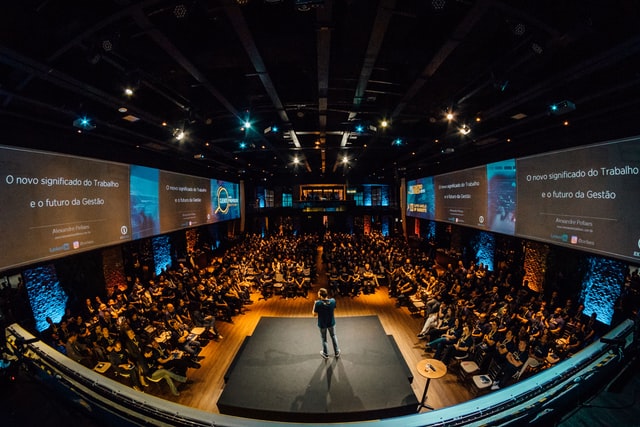- HOME
- Management
- Sustainable event planning: 5 takeaways from COP26
Sustainable event planning: 5 takeaways from COP26
- Last Updated : August 18, 2023
- 885 Views
- 6 Min Read

Our favorite topic at The Green Room—apart from event technology, of course—is sustainability, and we’ve written quite a bit about hosting eco-friendly events, why social sustainability is important for the events industry to recover, and creating accessible and inclusive event experiences. So, like the rest of the world, we were especially excited to see how the COP26 summit—the largest international gathering on climate change—would approach sustainability in practice when it came to putting on the event. This was even one of the feature stories in the November 2021 issue of PCMA’s Convene magazine.
In this article, we take a deeper look at the official COP26 Sustainability Report and the lessons all of us can learn from the event when it comes to approaching sustainability at our own events.
COP26 — A little background
Conference of the Parties (COP26)—the UN’s 26th Climate Change Conference—was the largest gathering on climate change and sustainability to date and was hosted jointly by the United Kingdom and Italy in Glasgow, Scotland from October 31 to November 12, 2021. Over 120 Heads of State and various government officials met in-person to create an action plan to combat climate change.
The event hosted over 40,000 attendees—22,274 party delegates, 14,124 observers, and 3,886 media representatives—traveling from around 200 countries. There were anywhere between 13,000 to 17,000 attendees most days.
5 ways COP26 championed event sustainability
COP26 makes for an interesting case study—it’s huge, sustainability got its spotlight, and most importantly, it happened towards the tail end of a global pandemic. Laura Lopez, the director of conference affairs for the United Nations Framework Convention on Climate Change (UNFCCC), puts this into perspective: “How can you possibly talk about climate change when what you’re doing is increasing the carbon footprint?”
They set some pretty high goals and created a full-on action plan—carbon neutrality, 100% renewable energy, economic growth, and more to push the boundaries of sustainability in the events sector.
These are some ways they made their event more sustainable (and how you can too), no matter the size of your event (or its budget).
Planning eco-friendly transport options
It’s not every day that you find an entire country willing to support an event’s sustainability goal, but when it does, the possibilities are pretty much endless. Here are just some of the things that COP26 (and the UK) did to make transportation more sustainable during the event:
A special electric train between the Netherlands and Scotland to bring attendees to COP26
Electric buses—five minutes apart—between Glasgow Queen Street and Glasgow Central stations to transport delegates
Free NextBikes for delegates to hire
Apart from this, the planning committee also used electric vehicles to both transport leaders to the summit and police to the venue. Some of these, like free bikes and electric vehicles, are easy to do at most events. Not just that, they even built “the world’s first completely off-grid, portable EV charge-post solution, powered by innovative battery storage units, with the latest Stage 5 generators run on locally sourced hydrotreated vegetable oil (HVO) as backup,” which was used to charge all the electric vehicles. How cool is that?
While not all event planners can do something on this level, we can definitely take inspiration. For example, find out if your event destination and event venue has bike tracks, or work with attendees to arrange group travel or carpooling to and from the venue and their hotels. You can even gamify this experience by hosting walking/biking challenges or creating a leaderboard.
Being intentional about energy consumption
After travel, energy spend (mostly electricity) is the second-biggest contributor to an event’s carbon footprint, accounting for almost 70% of the remaining amount. At the same time, while travel is largely dependent on the attendees, you have more control of energy expenditure at the event. And some of COP26's biggest sustainability wins—like the HVO fuel we spoke about in the above section or the other measures discussed below—happened onsite:
Solar panels to power the lights onsite
LED lighting throughout the venue
Cold water in temporary bathrooms and lowering the amount of hot water in other bathrooms to save on heating
The report states, “a total of 692,608kWh of renewable electricity was generated onsite during COP26 through onsite solar panels. On some days during the build, renewables generation covered all onsite electricity requirements.”
Not just that, “100% electricity consumption for COP26 was from renewable sources, either onsite generated renewable electricity (46%) or from Renewable Energy Generation Origin (REGO) certificates (54%).”
Addressing waste management creatively
Events produce a lot of waste, and most of it ends up in landfills. But what if you could upcycle waste so it actually benefits your event? Here are two examples of how waste was used rather innovatively to address COP26 energy requirements:
2,407,200 liters of Hydrotreated Vegetable Oil—made from waste oil—was used as fuel backup for the power grid and to supplement heating requirements
Methane gas—produced from organic waste broken down in the anaerobic digestion facility—was another source for renewable energy for the event
Plus, energy recovery was included even during the waste incineration process, and this energy was donated to the National Grid. Apart from this, there were also measures to segregate waste, reduce water consumption (which turned out to be a little challenging owing to the pandemic and strict sanitization protocols), and choosing only reusable material on site. One of our favorite instances of repurposing is Glasgow The Caring City’s Winter Wonderland experience, which used the set flats and scenic pieces from COP26.
The result of all this? The total waste produced was way less than the previous editions of the event, despite the increase in attendees—141,510 kg overall and only 3.7 kg per event.
Involving the local community
We talk a lot about the ecological impact of events, but not so much about its social impact. Yet, it's the host destination that feels the immediate impact of any event. Working with the local community—whether vendors, communities and groups, or even the government—can actually make for an interesting event experience that can benefit both the event organizer and the community. COP26’s Green Zone is a successful experiment in engaging the community. Quoting from their report:
“The Green Zone provided a space for the general public, youth groups, civil society, academia, artists, and businesses to have their voices heard through events, exhibitions, workshops, and talks promoting dialogue, awareness, education, and commitments. There were 100 exhibitors and 215 events held.”
Apart from actively engaging the community, Glasgow citizens were kept informed about road closures and other disruptions on the ‘Get Ready Glasgow’ website. Also, after the event, they partnered with Event Cycle to distribute items—carpets, graphics, textiles, wheelchairs, and even fridges—to the local community.
According to their sustainability report, “approximately 6,000 furniture items and home furnishing accessories used throughout the event have been donated to community groups and third sector organizations throughout Glasgow and Scotland, valued at over £500,000.”
Educating people on sustainability
Attendees, sponsors, suppliers, exhibitors, speakers, volunteers—that’s a lot of people who influence your event’s sustainability factor, a lot of people whose cooperation you need to achieve your goals. And the first step to doing this is educating them about sustainability.
The COP26 report states that over 400 hours of online training was provided for all participants, including suppliers, delegates, and partners. They also did target-group-specific training like teaching exhibitors how to reduce disposable waste at their booths and delegates about the green options—bikes, walking routes, and plant-based food options—available for them.
All event participants were also made aware of the event’s Sustainability Guiding Principles and how they can contribute towards it.
These days, it’s not possible to host an event that’s truly, 100% sustainable. However, when you account for sustainability early on into your plan—working with eco-friendly vendors, choosing a green destination, and more—and find ways to balance your event’s carbon footprint through activities that offset them post-event, you get a lot closer to achieving your goal. For the latter, you can take inspiration from COP26’s carbon offset strategy or use tools like TRACE by Isla or even free carbon footprint calculators like myclimate that can help you do this in a more planned way.
We hope you found this article interesting. We’d love to hear your thoughts on this topic—tweet us @ZohoBackstage and let us know how you’re making your events more sustainable.
 Nisha
NishaMarketing and content at Zoho Backstage. Cultural misfit. Armchair traveler. Productivity geek. Sometimes, I write poetry. Sometimes, it rhymes.












